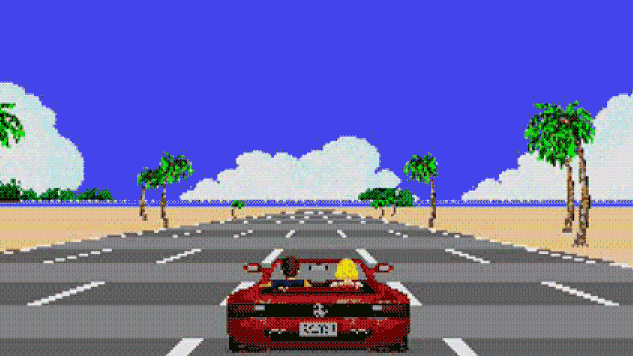
Seated in a luxury, red Ferrari Testarossa Spider, you slam your foot hard on the accelerator and pay witness to the colorful environments fading fast into memory behind you. No, you haven’t won big on the lottery; you’re playing Out Run, the legendary 1986 arcade game developed by Sega AM2. Boasting an incredibly energetic soundtrack and lush, detailed European landscapes, the game set itself apart from other racing games that prioritized competition by focusing instead on the experience of getting from point A to point B in style. After 30 years, this is just one of the many reasons why it’s still king among driving games.
Having found success with the exceptional arcade titles Hang-On and Space Harrier, the Japanese programmer Yu Suzuki was motivated to create Out Run for two equally simple but disparate reasons. The first was his longing to help Sega compete against Namco, who were the most successful Japanese manufacturer of racing games at the time; and the second was his love for the Burt Reynolds vehicle (pun intended) Cannonball Run, a film about a cross-country race through North America.
It was his desire to recreate the same course that had been taken by the film’s characters inside of a videogame, but his plans quickly changed after he realized a Pan-American road trip wouldn’t offer the most diverse collection of courses to navigate through. His gaze instead turned towards Europe.
Packing a video camera and some other recording equipment, Suzuki made an unusual decision for the time. He would travel to Europe himself, to collect information for the game. It was his hope that the research from his road trip would translate into more realistic and impressive courses within the game.
And this wouldn’t be the only time that members of the programming team would employ an irregular approach to development. Later on, the team also went to lengths to track down one of the few Ferraris in Japan to study, so as to better capture the handling and feel of the car. The result of all these field trips was the videogame Out Run as we know it today.
A deliberate departure from popular driving games like Namco’s Pole Position and Konami’s Road Fighter, Out Run took a more relaxed approach to driving, a fact perhaps best demonstrated by the lack of other racers on the course. Though you could chase high scores if you were so inclined, the journey in Out Run was really its own reward due to a great selection of alternative routes, musical tracks and landmarks to discover. And for those interested in a relaxing drive, this luxurious play style was further abetted by the game’s difficulty. By allowing players to pick whether to go ahead and take an easier route or to accept a bigger challenge, the game managed to successfully transcend the regular arcade-racing crowd, becoming accessible even to newcomers to the genre.
Whereas its contemporaries constantly forced individuals to assess and reassess their position and struggle to overtake others in order to win, Out Run instead focused predominately on capturing the player’s enjoyment. It achieved this feat through its multitude of distractions and its tight control scheme. Whether you’re drifting around corners on Coconut Beach or driving along a bumpy road through the middle of a wheat field, the player almost always feels like they’re in control of their vehicle, allowing them time to take in the refreshing sights and sounds of the experience.
As hinted at briefly above, the soundtrack is another aspect of Out Run that can’t be ignored. The composer Hiroshi Kawaguchi had previously scored Suzuki’s Hang-On and was the obvious choice of composer to be assigned the project. Given instructions by Suzuki to create eight-beat rock rhythms at a rollicking 150bpm tempo, he set about putting together the music for the game, but was unable to add vocals and guitar to the mixes due to the technical limitations of the hardware. In spite of this, the score he crafted has since gone on to become one of the most beloved in videogame history—a fact illustrated by the popularity of its recent vinyl reissue.
Giving the player a choice of three tunes (“Magical Sound Shower,” “Passing Breeze” and “Splash Wave”) on a mock radio, the finished score again hammered home the game’s aesthetic-driven design philosophy. Each track compliments the graphics on screen, contributing superb arrangements and catchy melodies to the gorgeous, brightly colored visuals.
With all that being said, it’s no surprise then that Out Run became an enormous hit for Sega upon its release, inspiring a bunch of console conversions, the most remarkable of which was the 1996 Sega Saturn port. There have even been multiple sequels over the years, including the Yu Suzuki produced Out Run 2 released in 2003, though the original still remains the best.
Today Out Run serves the dual purpose of being a fantastic time capsule of 1980s optimism as well as a salient reminder of how intelligent game design can help a title weather the decades. Jumping behind the wheel of the classic sports car is still as pleasurable as ever in 2016, a fact that can mostly be chalked up to the outstanding attention to detail that was paid towards sound, movement and imagery in the game.
When not glued to the latest release, Jack Yarwood spends his time writing and talking about videogames online. You can follow what he’s up to on his Twitter and on his blog.